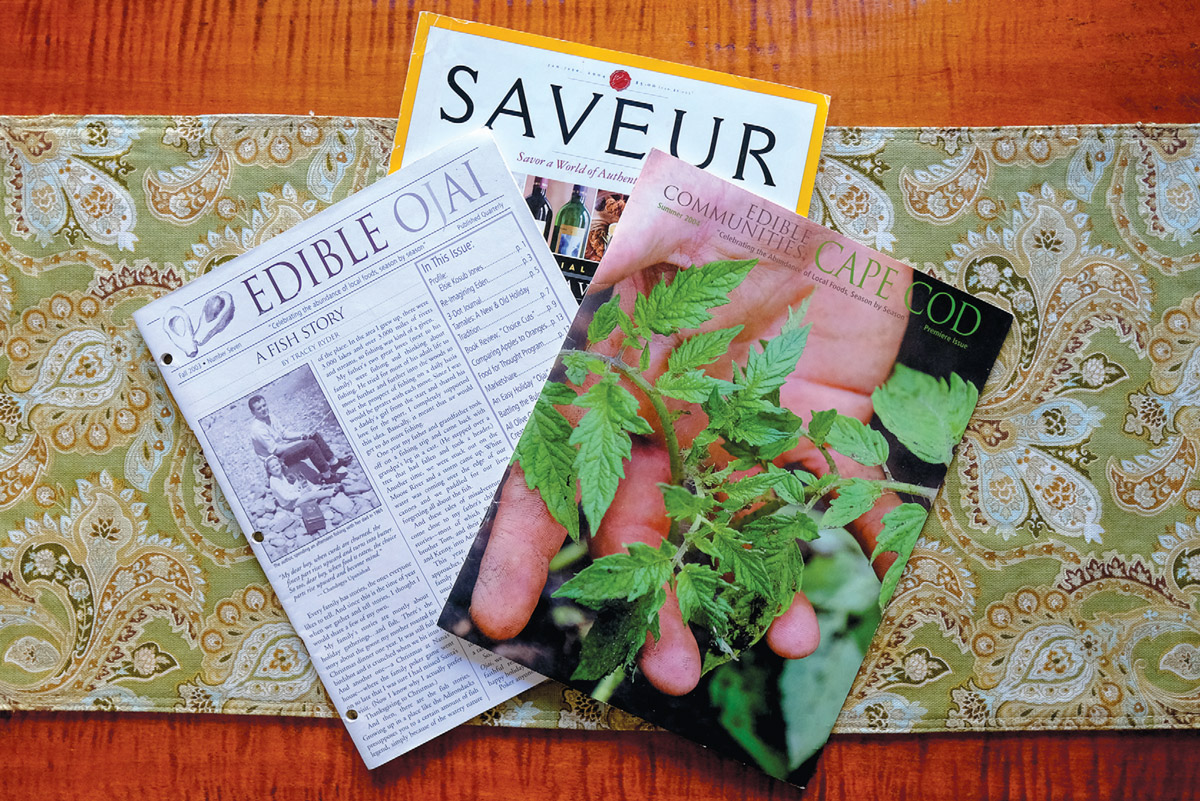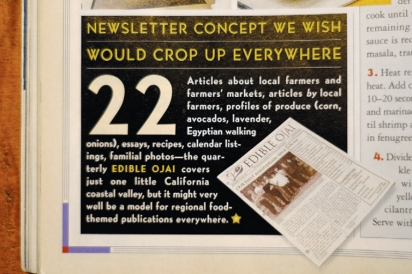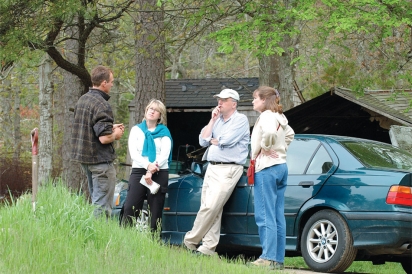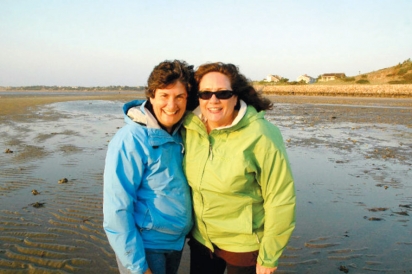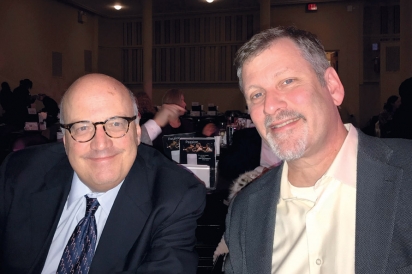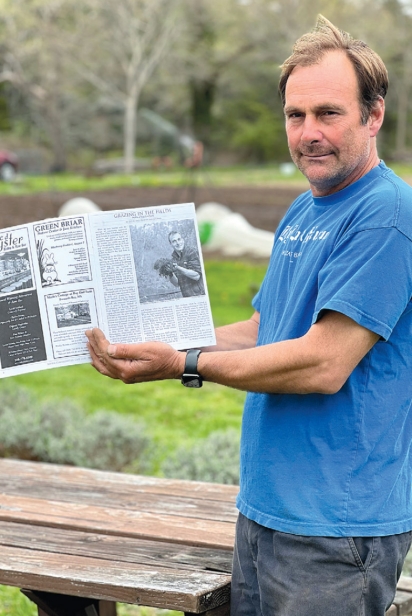Edible Cape Cod Turns 20
It took just 50 words to ignite a mini-industry.
The lead story in the January/February 2004 issue of Saveur was a roundup of the magazine’s 100 favorite foods, restaurants, people, places and things. The list included a short blurb with the headline “Newsletter Concept We Wish Would Crop Up Everywhere.”
“It was the two inches of ink that changed our lives forever,” says Tracey Ryder, who two years earlier had co-founded Edible Ojai, a local food-focused newsletter in southern California. Ryder and her partner, Carole Topalian, ran a design firm and a media agency in a small agricultural community about 80 miles northwest of Los Angeles. They decided to create a quarterly newsletter because, “we loved the farmers in our community and we loved all the food that was available,” Ryder says.
Saveur said Edible Ojai “might very well be a model for regional food-themed publications everywhere.” Readers agreed. “I think there were over 400 inquiries the first week that the magazine came out, so it was a little overwhelming,” says Ryder.
Ryder and Topalian saw an opportunity to create a family of like-minded publications but decided to start by helping to launch one in a very different locale. Ryder grew up spending summers on Cape Cod with her grandparents and was receptive when she heard from Doug and Dianne Langeland, who had honeymooned in Harwich, vacationed on the Cape for decades, and bought a home on the Cape four years earlier to be near family. A couple of food connoisseurs (Doug attended the French Culinary Institute in New York while between jobs), they were both feeling burned out from their corporate jobs. “They were eager to dig into the Cape Cod community, and we just hit it off immediately,” says Ryder.
“Tracey and Carole wanted to be geographically as far as possible from Ojai when they launched the next magazine, just to prove that it could be done, so they selected us,” says Dianne Langeland. Ryder and Topalian drove across the country with a station wagon filled with photography equipment, computers, printers and wine. “They moved into the house behind us for two weeks, and we spent that whole time getting to know each other and creating the first issue,” says Dianne Langeland.
“We went from completely clueless about magazine operations to having a magazine on the stands in a month’s time,” says Doug Langeland.
The summer 2004 debut issue of Edible Communities: Cape Cod, as it was then called, included the Langelands’ feature story about Bay End Farm in Buzzards Bay (see page 17), Topalian’s guide to do-it-yourself clambakes, and articles about blueberry picking and cooking with children. In a letter from the editor, Dianne Langeland wrote that they hoped to enhance the local food community, but “mostly we would like Edible Communities: Cape Cod to be FUN.”
“We were naturally curious about where our food came from,” says Doug Langeland. “Where are there farmers’ markets on the Cape? The answer was, there weren’t many [the debut issue listed the schedule for five of them], but what other food things are here? That’s how we set up the magazine. It helps someone follow their nose and find out where their food comes from, and that’s a powerful thing.”
Dianne says they wanted to discover and share the secrets of their new home. “Locavore was the word of the year that year,” she says. “It was the early days of the local food movement, so it was a lot of fun exploring and watching that movement hit the Cape and really take off.
“To be honest, I almost never had an editorial calendar. I tried to hit fishing, farming, restaurant, artisans in every issue, but I relied on the people who had the passion coming up to me and saying, ‘I want to write about this business. I want to write about this farmer.’ It was a grassroots, organic magazine. It’s embarrassing to admit it, but there was not a lot of forethought. It just grew by itself.”
The Langelands developed and nurtured a talented collection of contributing writers, including Tom Dott. Before moving to Asheville, NC, two years ago, Dott wrote over 100 articles for Edible Cape Cod and won three Eddies (now Best of Edible awards), a national honor awarded annually by Edible Communities, Inc. Dott’s only writing experience before being published in Edible Cape Cod was writing school papers, which he enjoyed, and funny emails, which captured the attention of his friend Doug Langeland.
“The stories that came out of left field were my favorite,” says Dott. One of his first stories, “The Vines That Bind,” about the owner of a pizzeria and candy store in Hyannis who made wine on the side in a back alley, won an Eddie for best feature story. A humorous piece he wrote about a young man struggling, grotesquely struggling, to swallow his first oyster won an Eddy for best short article. Among his other favorite articles were those about an attorney who walked away from the legal world to follow his passion for oyster farming and a guy who roasts coffee in a shed in his backyard in Woods Hole.
“I met all these unbelievable people and along the way I tried food that I’d never tried before and went to restaurants I may have driven by 15 times because I wasn’t sure what was behind the door,” he says. “Every single article was an adventure. I’ve gotten a couple of letters in the mail from people who love my writing, and that is such fodder for your soul. Everybody needs their ego stroked once in a while. Writing for Edible has been one of the highlights of my life.”
Another long-tenured contributor is Michelle Koch. She moved to Cape Cod from New Jersey in 1999 and began freelancing for local publications, including a magazine for kids and Cape Healing Arts magazine. An interest in food is in her blood; her paternal grandmother grew up on a beet farm in Canada and her father enjoyed leading family field trips, like packing Michelle and her siblings into the station wagon and searching for wild rice.
“I thought, I’ll just write a letter to Dianne,” says Koch. “She gave me a chance, and I’ve been writing for the magazine ever since.” Her first Edible article was about vermiculture (using worms to convert organic waste into compost). “I’ve since become a worm nut and I have worms at my house.”
Over the past 15 years, she’s visited a variety of farms and met plenty of animals – goats in Orleans, sheep in Falmouth, some few-hours-old pigs at the Cape Cod Organic Farm in Barnstable. One highlight was being chased by runner ducks in Harwich. “They kind of waddle and a lot of farms have them,” she says. “They’re very good at keeping down snails and slugs and different pests on farms, as well as ticks. The owner let his runner ducks loose and they came charging at me.”
She enjoys writing articles about people with unusual side businesses, like the Woods Hole scientists who use goats to rejuvenate meadows. “I’ve written lots of stories about people starting small businesses and it feels great to be able to share their inside story. You can see the difference that having a platform like Edible Cape Cod can make for people starting off or trying to expand their business, letting readers know who they are and what they do.”
In 2019, the Langelands decided it was time to let go of the magazine. “I just didn’t have the same energy about it, and I felt like I had written everything that I wanted,” says Dianne.
“When we started, we were the fresh voice, but it was time to move on,” says Doug. “It was a fantastic business to be involved in and an enormous amount of fun. I’d do it all over again in a heartbeat, even make the same mistakes again. It was just what we needed to leave the corporate world. We worked side-by-side for years, and we still like and love each other and are comfortable working together. So that’s nice, too.”
Larry and Cori Egan let Ryder know they were interested in taking over the magazine. Cori is a photographer who has experience in advertising sales, and Larry was already a regular writer for the magazine. “I’m blown away by what people are doing on Cape Cod, whether they’re farmers or fishermen,” says Larry. He had written about a computer software salesman who started growing garlic when he retired, and about the founder of Harvest Moon Farms in Barnstable, a former hedge fund manager who created a farm from scratch. “Those are the kinds of things that I don’t think most people were aware of before Edible Cape Cod was around,” says Cori.
“In the past, I had thought, Wouldn’t it be so great to take it over?” says Larry. “But I’d never said anything to anyone. It was just one of those pipe dreams.”
“The model is really living and breathing your community,” says Ryder. “Larry and Cori definitely did that, and we absolutely knew they were the right fit.”
The Egans teamed up with the Langelands to publish the winter 2020 issue and were on their own for the spring 2020 issue, which had a copy deadline in mid-March.
“We had everybody’s ads, we had stories written, we were taking final photos on March 13 at Cape Sea Grille, and then a few days later, the world shut down,” says Cori. After some sleepless nights, they delayed publication for a couple of weeks, and then faced an unexpected dilemma.
“It hit me like a ton of bricks,” says Larry. “We have 15,000 copies of these things and nobody’s going to want to touch them. Because that was back in the day where nobody touched anything.”
“At that point, everybody was cleaning their groceries,” says Cori. “We would wear gloves and masks while we opened the small box of magazines and put them out for display in the box. ‘Okay, hot off the presses. Nobody’s touched them.’”
“Everybody saw the new issue as a respite from the world,” says Larry. “I think it was a bit of normalcy from before times and it got snapped up just as usual. After that, we realized we were going to be okay. People are still going to want this magazine.”
More than ever, Cori says, people wanted to know where their food came from. “They wanted to grow their own, and the farmers’ markets were more popular than ever because they were outside, and had locally grown and made products,” she says.
The Egans have made only minor changes in their five years as publishers. “We’re the stewards of this wonderful publication that Doug and Dianne started,” says Larry. “Our first couple of years at least, we were all about ‘if it ain’t broke, don’t fix it’. It’s such a wonderfully accepted magazine. You don’t need to reinvent the wheel because the wheel is spinning nicely and everybody loves that wheel. Then along the way, we can tweak this, we can tweak that, our designer Kristen [vonHentschel] has freshened up the look, and that’s where we are.”
One thing that’s stayed constant is that Edible Cape Cod is a food magazine that doesn’t run restaurant reviews.
“I’m not interested in reviewing some place’s plate of chicken parm,” says Larry. “How many different ways can you say the word delicious? I’m far more interested in the backstory of the chef who opened his own restaurant and where he came from and the challenges he’s faced and overcome. I think that’s what people appreciate. When we get a little beat down by the process and we’re just exhausted, then we run into people and they say, ‘Oh, I love this magazine. When is the next issue coming out?’ We’re doing this for a good reason.”
Edible Cape Cod is the oldest of the Ojai spinoffs, which now number 80, including publications in Southeastern Massachusetts, Boston, Brooklyn, Toronto and Alaska. “They’re all in the same business, but they’re not direct competitors of one another,” says Ryder. “What that does is create an environment for collaboration and support. The biggest benefit is all 80 of these publishers want to see each other succeed, so they go to great lengths to help advise and share information and communicate.”
“We have this hyper-local magazine,” says Cori Egan, “Everybody we write about is here. Everybody who advertises with us, except for the few Edible Communities’ national ads, it’s all local. But we have this safety net that’s behind us making sure that we have what we need.”
Asked if the mission of the Edible publications has evolved much compared to what she had in mind with the first Ojai issue, Ryder says, “I think it’s broadened, but I don’t think it’s changed. At the end of the day, if you asked, what is the core of Edible? I would still say it’s to support the efforts of American farmers.”
As for Edible Cape Cod? “Dianne has always said – and I don’t know if she ever put it down in writing in a letter from the editor – it really is a love letter to Cape Cod,” says Larry Egan. “It’s celebrating all the good things that people are doing for themselves, for each other and for the environment.”
Bill O’Neill got his start in the communications industry delivering the Cape Cod Times on his bicycle. When he was a bit older, he was the lifestyle editor at the Times. As a freelancer, he writes about healthcare, pop music and other topics. He lives in Buzzards Bay and enjoys biking, hiking and kayaking


